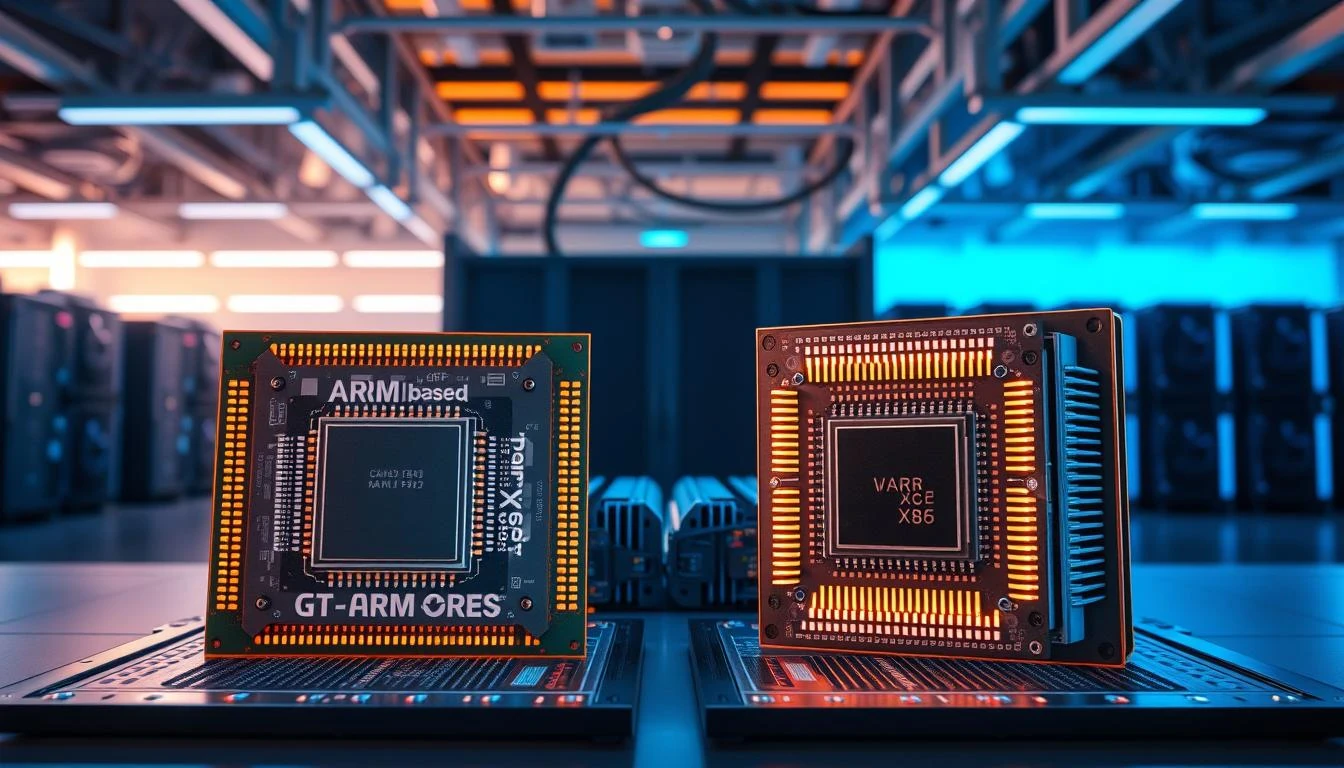
AI PCs Set to Dominate by 2029 as Demand Skyrockets
According to Gartner, AI-powered PCs are on the rise, expected to account for 31% of the global PC market by the end of 2025, and skyrocketing to 55% by 2026. This surge is driven by increasing adoption of AI technology across various industries, fueling digital transformation. As a result, we are witnessing a significant shift in both enterprise demand and consumer demand for AI PCs
The recent partnership between OpenAI and Broadcom to produce AI chips further accelerates this trend, indicating a future where AI PCs become the standard. As we move towards 2029, it's clear that AI PCs are set to dominate the market.
Key Takeaways
- Gartner predicts AI PCs to account for 55% of the global PC market by 2026.
- OpenAI's partnership with Broadcom boosts AI chip production.
- AI technology adoption drives digital transformation.
- Enterprise and consumer demand for AI PCs is on the rise.
- AI PCs are expected to become the standard by 2029.
The Current State of AI PC Market
With the increasing adoption of AI technology, the AI PC market is poised for substantial growth. As we explore the current state of this market, it's essential to understand the defining features and capabilities of modern AI PCs.
Definition and Capabilities of Modern AI PCs
Modern AI PCs are equipped with advanced hardware and software that enable them to perform AI tasks efficiently. One of the key components driving this capability is the Neural Processing Unit (NPU).
Neural Processing Units (NPUs) and Their Functions
NPUs are designed to handle complex AI computations, allowing for faster processing of tasks such as image recognition, natural language processing, and predictive analytics. By offloading these tasks from traditional CPUs and GPUs, NPUs improve overall system performance and reduce power consumption.
On-Device AI Processing Advantages
On-device AI processing offers several advantages, including enhanced security, reduced latency, and improved privacy. By processing AI tasks locally on the device, sensitive data is not transmitted to the cloud, reducing the risk of data breaches.
| Feature | Traditional PCs | AI PCs |
| Processing Unit | CPU/GPU | NPU |
| AI Task Handling | Limited | Efficient |
| Security | Variable | Enhanced |
As the AI PC market continues to evolve, we can expect to see further innovations in NPU technology and on-device AI processing. This will drive growth in both enterprise and consumer segments, as users increasingly demand more powerful and efficient computing solutions.
AI PCs Will 'Become the Norm' by 2029 as Enterprise and Consumer Demand Surges
As we approach 2029, AI PCs are poised to become the standard in the technology industry. The growing demand for AI capabilities in PCs is driving this transformation, with both enterprise and consumer sectors playing a crucial role.
Gartner's Market Predictions
Gartner's recent analysis provides valuable insights into the future of the AI PC market. According to their predictions, AI PCs are expected to account for a significant share of the global PC market in the coming years.
31% Market Share by 2025 Analysis
By 2025, Gartner predicts that AI PCs will make up 31% of the global PC market. This growth is driven by increasing demand from enterprises looking to leverage AI for business applications.
55% Market Share by 2026 Projection
Furthermore, Gartner projects that by 2026, AI PCs will account for 55% of the global PC market. This rapid growth underscores the accelerating adoption of AI technology across both enterprise and consumer markets.
| Year | AI PC Market Share |
| 2025 | 31% |
| 2026 | 55% |
The implications of Gartner's predictions are significant. As AI PCs become more prevalent, we can expect to see a shift in how technology is developed and utilized across various industries.
With enterprise demand driving the adoption of AI PCs, businesses are likely to benefit from enhanced productivity and efficiency. As consumer demand also grows, AI PCs will become increasingly accessible to a wider audience.
Enterprise Adoption: Leading the AI PC Revolution
With the surge in digital transformation, enterprises are turning to AI PCs to lead the revolution. As businesses strive to stay competitive in a rapidly evolving technological landscape, the adoption of AI PCs is becoming increasingly crucial.
Business Use Cases Accelerating Demand
Enterprises are adopting AI PCs for various business use cases that are transforming their operations. The key drivers behind this adoption are the need for enhanced data analysis, improved decision-making, and increased operational efficiency.
Data Analysis and Decision Support Applications
AI PCs are being utilized for advanced data analysis and decision support applications. These capabilities enable businesses to derive actionable insights from complex data sets, thereby supporting informed decision-making.
- Enhanced data processing capabilities
- Improved predictive analytics
- Real-time data analysis
By leveraging these capabilities, enterprises can gain a competitive edge in their respective markets. The use of AI PCs for data analysis is a significant factor in driving business growth and innovation.
Workflow Automation and Efficiency Gains
Another significant use case for AI PCs is workflow automation. By automating routine tasks, businesses can achieve substantial efficiency gains, allowing them to allocate resources more effectively.
- Automation of repetitive tasks
- Streamlining of business processes
- Enhanced productivity
As enterprises continue to adopt AI PCs for workflow automation, they are experiencing significant improvements in operational efficiency. This, in turn, is driving further demand for AI PCs as businesses seek to maximize their return on investment.
Consumer Market Trends: From Early Adopters to Mainstream Users
As AI PCs continue to evolve, we're witnessing a significant shift in consumer market trends. The growing demand for AI-enhanced tools and applications is driving this change, with consumers increasingly adopting AI PCs for various tasks.
Shifting Consumer Preferences and Expectations
Consumer preferences are shifting towards AI-enhanced devices that offer improved performance and capabilities. This shift is driven by the increasing availability of AI-powered applications and tools that cater to diverse consumer needs.
AI-Enhanced Creative and Productivity Tools
AI-enhanced creative and productivity tools are becoming increasingly popular among consumers. These tools offer advanced features such as automated editing, content creation, and workflow optimization, making them attractive to professionals and hobbyists alike.
Gaming and Entertainment Applications
Gaming and entertainment applications are also driving the demand for AI PCs. AI-powered gaming platforms offer enhanced gaming experiences with features like real-time rendering, personalized gaming, and advanced analytics.
To illustrate the growing demand for AI PCs, let's examine the market trends in a tabular format:
| Application | AI-Enhanced Features | Consumer Benefits |
| Creative Tools | Automated editing, content creation | Increased productivity, improved quality |
| Gaming | Real-time rendering, personalized gaming | Enhanced gaming experience, immersive gameplay |
| Productivity Tools | Workflow optimization, task automation | Streamlined workflows, reduced workload |
As shown in the table, AI PCs are offering a range of benefits to consumers across various applications. With the continued advancement of AI technology, we can expect to see even more innovative applications and tools emerge, further driving the adoption of AI PCs.

OpenAI's Strategic Partnership with Broadcom
In a significant move, OpenAI has partnered with Broadcom to develop custom silicon for AI applications. This collaboration is set to revolutionize the AI chip production landscape, enabling OpenAI to further enhance its AI capabilities.
Collaboration Agreement Details
The partnership between OpenAI and Broadcom involves a comprehensive collaboration agreement that outlines the terms of their joint effort in AI chip development. The agreement encompasses several key aspects, including investment scale, resource allocation, and intellectual property sharing.
Investment Scale and Resource Allocation
The investment scale for this project is substantial, with both companies committing significant resources to drive innovation in AI chip technology. The allocation of resources includes:
- Dedicated teams for research and development
- State-of-the-art manufacturing facilities
- Advanced technology infrastructure
Intellectual Property and Technology Sharing
A crucial aspect of the collaboration agreement is the sharing of intellectual property and technology between OpenAI and Broadcom. This includes:
- Patent sharing for AI-related innovations
- Joint research initiatives
- Access to each other's proprietary technologies
This strategic partnership is poised to accelerate the development of AI chips, enabling OpenAI to enhance its AI models and applications. By leveraging Broadcom's expertise in semiconductor technology, OpenAI is well-positioned to drive advancements in the field.
As the AI landscape continues to evolve, collaborations like the one between OpenAI and Broadcom will play a crucial role in shaping the future of AI computing. With a focus on custom silicon development, this partnership is set to make a significant impact on the tech industry.
The Race for AI Chip Dominance
As AI continues to transform industries, the demand for specialized AI chips is skyrocketing, sparking a fierce competition for dominance. The need for more powerful and efficient AI processors is driving innovation, with companies like OpenAI at the forefront of this technological race.
OpenAI's Strategy to Reduce Nvidia Dependence
OpenAI is developing custom silicon to reduce its reliance on Nvidia, a company that currently dominates the AI chip market. This strategic move is aimed at improving performance and efficiency in AI processing. By creating its own custom AI chips, OpenAI can tailor its hardware to specific needs, potentially gaining a competitive edge.
Custom Silicon Development Approach
OpenAI's custom silicon development involves designing and manufacturing chips that are optimized for AI workloads. This approach allows for greater control over performance, power consumption, and cost. Custom AI chips can be designed to accelerate specific AI tasks, such as matrix multiplication and convolution operations. By optimizing hardware for AI algorithms, OpenAI can achieve significant improvements in processing speed and efficiency.
Performance Targets and Efficiency Goals
The development of custom AI chips by OpenAI is focused on achieving high performance and efficiency. The goal is to create chips that can handle complex AI models with reduced latency and power consumption. To achieve this, OpenAI is likely leveraging advanced semiconductor manufacturing processes and innovative chip architectures. According to industry experts, "Custom AI chips have the potential to revolutionize the field by providing unprecedented levels of performance and efficiency."
In conclusion, the race for AI chip dominance is intensifying, driven by the growing demand for AI processing power. OpenAI's strategy to develop custom silicon is a significant step in this direction, aiming to reduce dependence on Nvidia and achieve superior performance and efficiency. As the AI landscape continues to evolve, the importance of custom AI chips is likely to grow, shaping the future of AI computing.
Computing Power Requirements for Next-Generation AI Models
As we move towards more sophisticated AI models, the need for advanced computing infrastructure is becoming increasingly evident. The rapid evolution of AI technology is driving an unprecedented demand for computing power, and next-generation models like GPT-5 are at the forefront of this trend.
The computational demands of advanced language models are significant, requiring substantial processing power to handle complex algorithms and large datasets. This has led to a surge in demand for high-performance computing hardware, including specialized AI accelerators and high-speed memory.
GPT-5 and Beyond: Infrastructure Needs
The infrastructure needs for GPT-5 and beyond are multifaceted, encompassing not only computing power but also memory, storage, and networking capabilities. To support these advanced models, data centers and cloud providers are investing heavily in upgrading their infrastructure.
Computational Demands of Advanced Language Models
Advanced language models like GPT-5 require significant computational resources to process and analyze vast amounts of data. This includes the need for high-performance GPUs, TPUs, and other specialized hardware designed to accelerate AI workloads.
Energy Efficiency and Sustainability Concerns
As AI models become increasingly complex, energy efficiency and sustainability concerns are coming to the forefront. Data centers and cloud providers are exploring ways to reduce their environmental impact, including the use of renewable energy sources and more efficient cooling systems.
The need for more efficient and sustainable computing infrastructure is driving innovation in the field, with companies exploring new architectures and technologies to support the demands of next-generation AI models.
Platform Wars: ARM vs. x86 in AI Computing
The AI computing landscape is witnessing a significant shift with the ongoing platform wars between ARM and x86. As AI technology advances, the choice between these two architectures is becoming increasingly critical for both enterprises and consumers.
Technical Advantages of Each Architecture
Both ARM and x86 architectures have their unique technical advantages in AI computing. ARM architecture is known for its power efficiency, which is crucial for edge AI devices and mobile applications. On the other hand, x86 architecture has traditionally dominated the server and desktop markets, offering high performance for complex AI computations.
Performance Characteristics and Efficiency Profiles
When it comes to performance characteristics, x86 processors generally offer higher processing power, making them suitable for demanding AI workloads. However, ARM processors have made significant strides in recent years, improving their performance while maintaining low power consumption.
The efficiency profiles of these architectures also vary. ARM's focus on power efficiency makes it an attractive choice for battery-powered devices and edge AI applications. In contrast, x86's high-performance capabilities come at the cost of higher power consumption, which can be a limiting factor in certain scenarios.
Software Ecosystem Compatibility
Software ecosystem compatibility is another critical factor in the platform wars. x86 has a more established software ecosystem, with many AI frameworks and tools optimized for x86 architecture. However, ARM is rapidly gaining ground, with many software vendors now supporting ARM-based systems.
To illustrate the differences between ARM and x86 in AI computing, let's examine a comparative analysis:
| Feature | ARM | x86 |
| Power Efficiency | High | Low |
| Processing Power | Moderate | High |
| Software Ecosystem | Growing | Mature |

As the AI computing landscape continues to evolve, understanding the strengths and weaknesses of ARM and x86 architectures is crucial. By considering factors such as performance characteristics, efficiency profiles, and software ecosystem compatibility, developers and enterprises can make informed decisions about which platform best suits their AI computing needs.
Reliance's AI Innovations in the Indian Market
Reliance is making significant strides in the Indian AI market with its innovative Jio AI Cloud. As a major player in the Indian technology sector, Reliance's advancements in AI are expected to have a substantial impact on the market. The company's focus on developing cutting-edge AI solutions is poised to drive growth and adoption across various industries.
Jio AI Cloud: Features and Capabilities
Jio AI Cloud is a comprehensive AI solution designed to cater to the diverse needs of the Indian market. With its advanced features and capabilities, Jio AI Cloud is set to revolutionize the way businesses operate in India.
Smart Cloud-Based Memory Architecture
The Jio AI Cloud boasts a smart cloud-based memory architecture that enables efficient data processing and storage. This architecture is designed to provide scalable and secure solutions for businesses, ensuring seamless integration with existing infrastructure.
Integration with Existing Jio Services
Jio AI Cloud is integrated with existing Jio services, enhancing the overall user experience. This integration enables users to access a wide range of AI-powered services, from data analytics to personalized recommendations.
| Feature | Description | Benefits |
| Smart Cloud-Based Memory Architecture | Efficient data processing and storage | Scalable and secure solutions |
| Integration with Existing Jio Services | Enhanced user experience | Access to AI-powered services |
In conclusion, Reliance's Jio AI Cloud is a significant innovation in the Indian AI market. With its advanced features and capabilities, it is poised to drive growth and adoption across various industries. As the Indian market continues to evolve, Reliance's commitment to AI innovation is expected to play a major role in shaping the technological landscape.
Regional Market Dynamics and Growth Patterns
As AI PCs continue to gain traction, understanding regional market dynamics is crucial for industry stakeholders. North America is at the forefront of this trend, driven by significant corporate investment and growing consumer demand.
Emerging Trends in North America
North American AI PC adoption is witnessing a substantial surge, fueled by corporate investment in AI infrastructure and a growing consumer base seeking enhanced computing capabilities. This trend is expected to continue, with enterprises driving the demand for AI-powered solutions.
Corporate Investment and Implementation Rates
Corporate investment in AI PCs is on the rise, with companies recognizing the potential of AI-driven technologies to enhance productivity and efficiency. As a result, implementation rates are expected to increase, driving growth in the regional market.
Consumer Market Segmentation and Behavior
Consumer demand for AI PCs is also growing, driven by the need for advanced computing capabilities and enhanced user experiences. Market segmentation reveals a diverse range of consumers, from early adopters to mainstream users, each with unique preferences and expectations.
FAQ
What are AI PCs, and how do they differ from traditional computers?
AI PCs are computers that integrate artificial intelligence (AI) technology, enabling faster and more efficient processing of AI tasks. They differ from traditional computers in their ability to perform AI tasks on-device, reducing reliance on cloud processing.
What is driving the growth of the AI PC market?
The increasing adoption of AI technology in various industries is driving the growth of the AI PC market. Enterprises and consumers are adopting AI PCs due to their technical advantages and potential applications.
What are Gartner's predictions for the AI PC market?
Gartner predicts that AI PCs will become the norm by 2029, with a significant market share expected by 2025 and 2026. Their predictions provide valuable insights into the future of the market.
How is OpenAI's partnership with Broadcom impacting the AI chip market?
OpenAI's partnership with Broadcom is expected to enhance its AI chip production capabilities, potentially reducing its dependence on Nvidia. This partnership has significant implications for the AI chip market.
What are the computing power requirements for next-generation AI models?
Next-generation AI models, such as GPT-5, require significant computing power and infrastructure. Sustainability concerns are also becoming increasingly important as AI models continue to evolve.
What is the difference between ARM and x86 architectures in AI computing?
ARM and x86 architectures have different technical advantages and software ecosystem compatibility. Understanding these differences is essential for determining the best architecture for AI computing applications.
How is Reliance innovating in the Indian AI market?
Reliance is developing its AI capabilities through Jio AI Cloud, which offers various features and capabilities. This innovation is expected to have a significant impact on the Indian AI market.
What are the regional market dynamics and growth patterns for AI PCs?
Regional markets, such as North America, are experiencing different adoption trends and growth patterns for AI PCs. Understanding these dynamics is essential for determining the potential implications for regional markets.
What are the benefits of on-device AI processing in AI PCs?
On-device AI processing in AI PCs enables faster and more efficient processing of AI tasks, reducing reliance on cloud processing and enhancing overall performance.
How are enterprises adopting AI PCs, and what are the benefits?
Enterprises are adopting AI PCs due to their technical advantages and potential applications. Business use cases are accelerating demand, and AI PCs are expected to have a significant impact on enterprise operations.






































